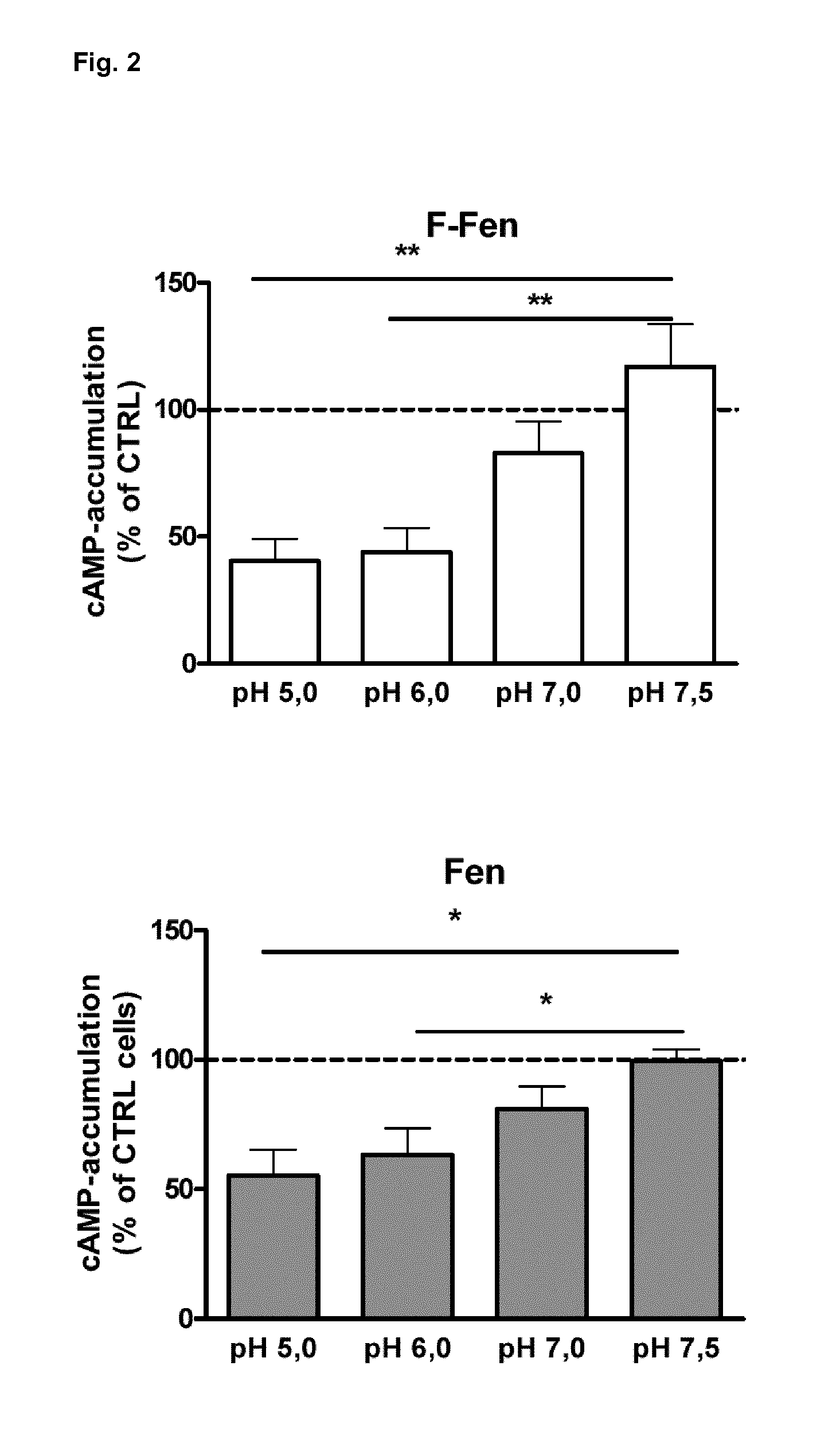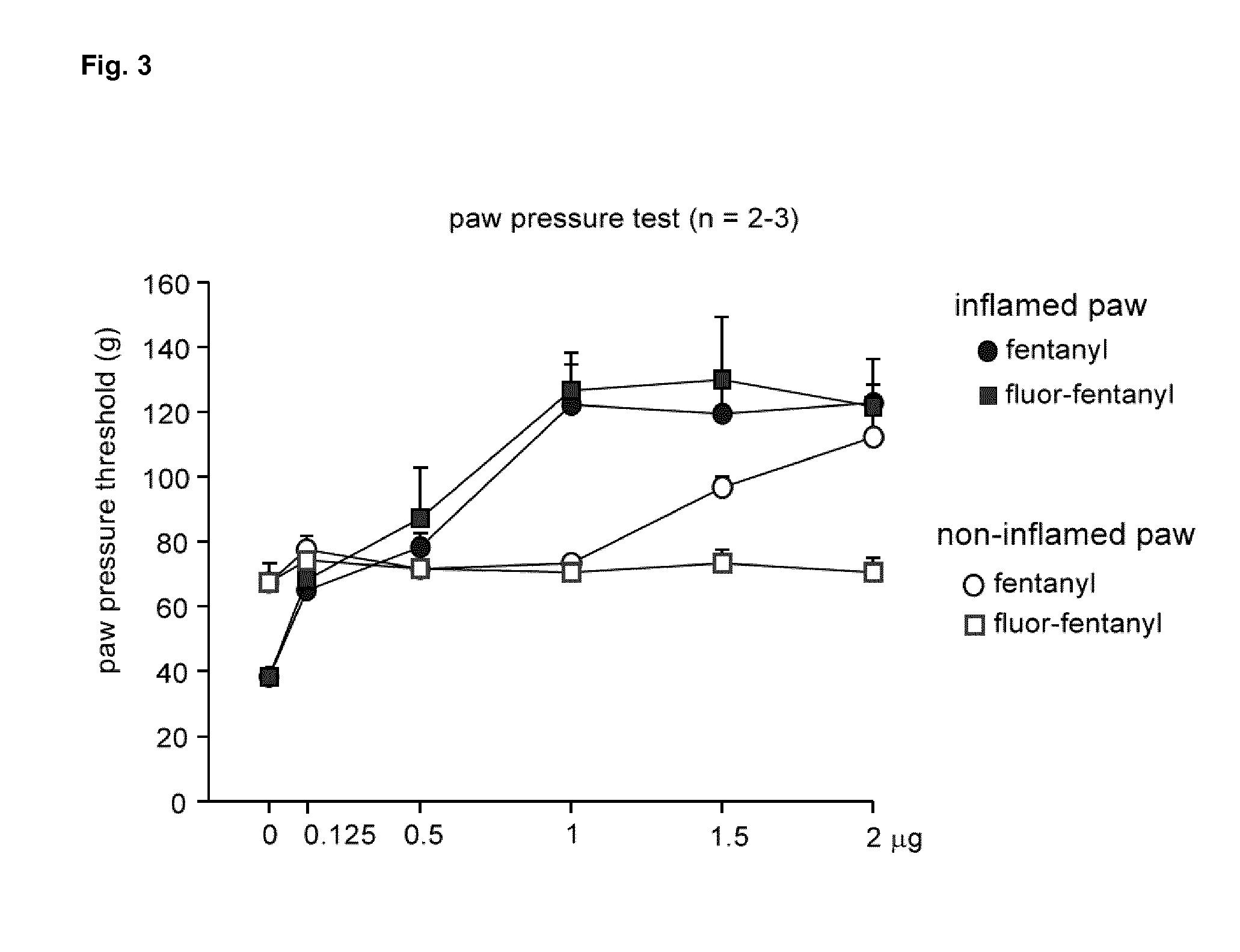Fentanyl derivatives as ph-dependent opioid receptor agonists
a technology of ph-dependent opioid receptor and derivatives, which is applied in the direction of heterocyclic compound active ingredients, biocide, organic chemistry, etc., can solve the problems of limited use of currently available opioid analgesics, limited availability of opioid analgesic drugs, and few methods for effective us
- Summary
- Abstract
- Description
- Claims
- Application Information
AI Technical Summary
Benefits of technology
Problems solved by technology
Method used
Image
Examples
example 1
Synthesis of F-Fentanyl
[0052]The synthesis of fluoro-fentanyl (F-fentanyl; (±)-N-(3-Fluor-1-phenethylpiperin-4-yl)-N-phenylpropionamide) was carried out according to the following:
[0053]Step 1: Production of a Silyl Enol Ether
[0054]The reactant (3 g; 15.056 mmol; 1 eq) was dissolved in dry DMF under Argon and was subsequently mixed with triethylamine (1953 mg; 18.079 mmol; 2.4 eq) and chlortrimethylsilane (5 mL; 36.134 mmol; 1.2 eq), one after the other. The reaction ran for 16 hours at 80 deg C. The reaction mixture was transferred to a separating funnel with cyclohexane (100 ml) and washed 3 times with sodium hydrogen carbonate solution (3×40 ml). After drying over magnesium sulphate and concentrating under vacuum, the product is rinsed 4 times with toluene in order to completely remove the DMF. A yellow-brown oil is obtained.
[0055]Step 2: Fluorination
[0056]The raw product from step 1 (2566 mg; 9.453 mmol; 1 eq) was dissolved under Argon in dry acetonitrile and mixed with Selectfl...
example 2
Structural and Physical Characteristics of F-Fentanyl
[0068]The synthesized compound had a formula of C22H27FN2O, with a molecular weight of 354.47 g / mol and melting temperature of 110-114 deg C.
[0069]The structure of the fluoro-fentanyl (F-fentanyl, (±)-N-(3-Fluor-1-phenethylpiperin-4-yl)-N-phenylpropionamide) compound synthesized as described above was determined using liquid chromatography coupled with mass spectrometry (LCMS), and 1H, 13C and 19F spectra were obtained using NMR for the desired product.
[0070]1H NMR (CDCl3): δ 7.433, 7.366, 7.354, 7.296, 7.275, 7.260, 7.213, 7.188, 7.167, 7.049, 5.270, 5.146, 4.635, 4.602, 4.553, 4.527, 3.343, 3.018, 2.991, 2.767, 2.626, 2.464, 2.429, 2.370, 2.336, 2.225, 1.996, 1.605, 1.583, 1.529, 1.511, 1.444, 1.416, 1.214, 1.035 ppm.
[0071]13C NMR (CDCl3): δ 174.404, 139.978, 139.323, 131.231, 131.151, 130.157, 129.381, 128.626, 128.529, 128.392, 128.193, 126.073, 88.831, 87.064, 59.968, 56.060, 55.881, 55.060, 55.881, 55.061, 54.879, 52.505, 33...
example 3
Mu-Opioid Receptor Function In Vitro
[0073]We used transfected HEK-293 cells and cultured dorsal root ganglion (DRG) neurons to examine mu-agonist binding, GTPγS binding, cAMP formation and modulation of TRPV1 currents by mu-agonists. Incubation of HEK-293 cells at different pH-values was initiated after the expression of mu-opioid receptors at the membrane surface was completed and stable. Affinity and number of mu-ligand (3H-DAMGO) binding sites were slightly (nonsignificantly) lower at pH 5.5 compared to pH 7.5 (Tab. 1). Preincubation with the adenylyl cyclase activator forskolin (FSK; 10 μM) and the phosphodiesterase inhibitor 3-isobotyl-1-methylxanthin (IBMX; 2 mM) (control groups representing 100% cAMP accumulation compared to unstimulated cells) yielded no significant differences between pH values of 5.0, 6.0, 7.0 and 7.5 (FIG. 1). However, suppression of FSK / IBMX-stimulated cAMP formation by DAMGO and morphine was markedly stronger at pH 5.0 than at pH 7.5 (Tab. 1), indicatin...
PUM
| Property | Measurement | Unit |
|---|---|---|
| pKa | aaaaa | aaaaa |
| pKa | aaaaa | aaaaa |
| pKa | aaaaa | aaaaa |
Abstract
Description
Claims
Application Information
 Login to View More
Login to View More - R&D
- Intellectual Property
- Life Sciences
- Materials
- Tech Scout
- Unparalleled Data Quality
- Higher Quality Content
- 60% Fewer Hallucinations
Browse by: Latest US Patents, China's latest patents, Technical Efficacy Thesaurus, Application Domain, Technology Topic, Popular Technical Reports.
© 2025 PatSnap. All rights reserved.Legal|Privacy policy|Modern Slavery Act Transparency Statement|Sitemap|About US| Contact US: help@patsnap.com



